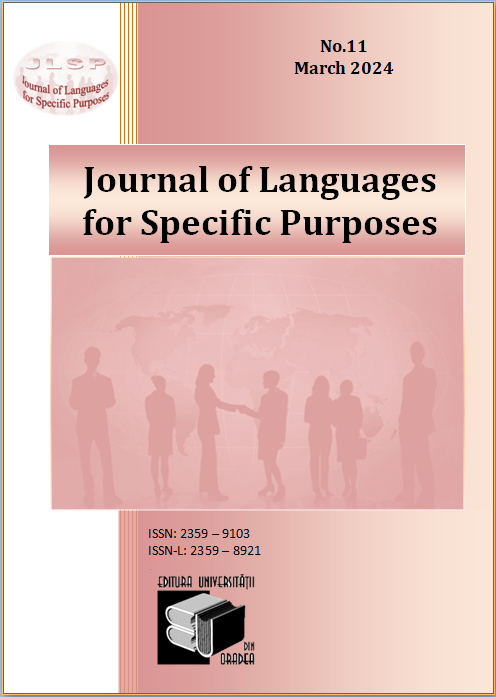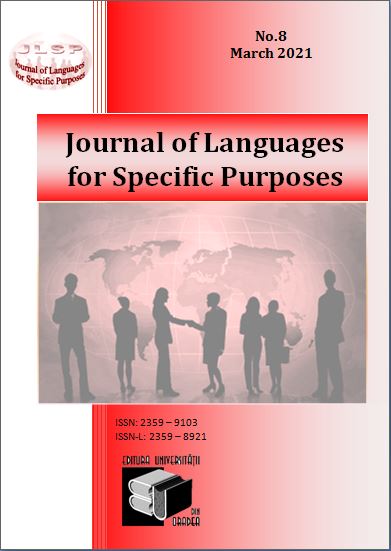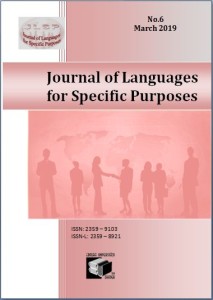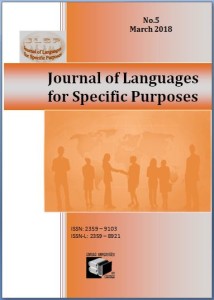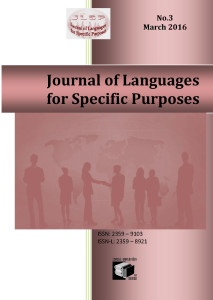12th Issue – March 2025
Thursday, September 25th, 2025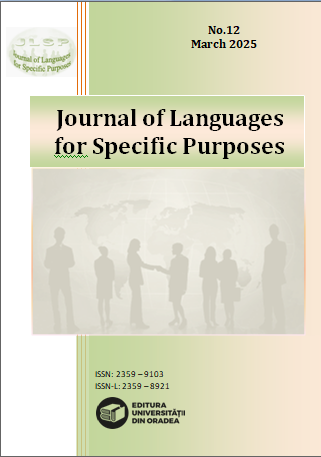
Full volume of The Journal of Languages for Specific Purposes (JLSP) – 12th Issue – March 2025
Title: COMMUNICATION IN BUSINESS ENGLISH – NEW CONTEXTS AND NEW APPROACHES IN TEACHING IT
Author(s): Cristina-Laura Abrudan
Abstract: The reflection of time in teaching Business English is definitely an immense one, as language is about communication and the development of learning it, walks hand in hand with the societies which give rise to it. What does this mean? Being human activities, both teaching and learning a foreign language are as well social as they are linguistic. The development of the societies led to an unbelievable technological development which comes as an aid in the process of teaching and learning Business English. Among some other factors, the gradual economic globalization has led to a great demand on teaching English for specific purposes, as part of English Language Teaching. Being widely used in a globally connected world, the importance of Business English is increasing more and more, as the market is dominated by multinational companies which need their staff to be fluent in English. Thus, teachers face the need of keeping the pace with the fast-developing technological world, try to find new methods of boosting the teaching process. Moreover, teaching Business English has already developed its own methodology, involving specific language, specific types of communication in a certain context, as it is designed to meet the exact needs of the learners. The general term of Business English is centered on the appropriate language, approaching it in terms of vocabulary, grammar, case study, and discourse. The goal of all the persons involved in this complex process is to create users of the language who communicate effectively, in correspondence as well as in face to face situations. The present paper approaches new ideas, new methods that can be put into practice in the process of teaching Business English. The topics of the Business English include business phrases, terms of sale, advertising, marketing, tourism, management – all these requiring the teacher’s ability to select, develop, combine the material in order to boost the results of the students involved in the process of learning.
Keywords: Business English; teaching methods; communication in business; teaching strategies.
Pagination: 7-13
Title: EVALUATING AUTHENTIC BUSINESS SPANISH TASKS: A COMPARATIVE STUDY ACROSS DIFFERENT INSTITUTIONS
Author(s): Sergio Adrada-Rafael, Gabriela DeRobles
Abstract: The present study delves into the field of Spanish for specific purposes (SSP) by assessing a series of authentic tasks implemented in two Business Spanish courses at distinct institutions in the United States with differing modalities: 1) a small private university on the East coast (n=18) with a face-to-face teaching modality and 2) a large public university in the Midwest (n=9) with an online asynchronous modality. The tasks, previously identified through a Needs analysis (author, 2017), included finding a real job offer in a Spanish-speaking country, preparing a Curriculum Vitae, writing a cover letter, and performing a mock job interview. These tasks required individual and collaborative work throughout the semester. At the end of the term, students completed an anonymous survey consisting of nineteen quantitative and qualitative questions evaluating the tasks’ relevance, usefulness, and difficulty. Overall, results revealed that participants from both institutions and modalities valued the usefulness of this task sequence, often rating it as equally or more useful than the rest of the course content, while identifying the job interview as the most challenging task. Furthermore, notable differences between teaching modalities emerged, with online asynchronous students expressing a desire for additional peer interaction compared to the face-to-face counterparts. These findings shed light on the importance of developing, implementing, and adapting SSP authentic tasks to closely resemble real-world job expectations upon graduation while also considering the unique needs of diverse educational settings and modalities. This study provides valuable insights for instructors and program directors in Languages for Specific Purposes (LSP) to develop curricula that better prepare students for globalized workplaces.
Keywords: Spanish for Specific Purposes (SSP); Task-Based Language Teaching (TBLT); Business Spanish; Teaching Modality.
Pagination: 15-29
Title: THE IMPACT OF INTERACTION ON SECOND-LANGUAGE ACQUISITION AND LISTENING
Author(s): Michael Amankwaa Adu, Levina N. Abunya, Edward Owusu, Gifty Budu
Abstract: The interaction hypothesis of second-language acquisition states that the development of language proficiency can be facilitated by face-to-face interaction and communication between native speakers of the language and language learners. This paper examines the relationship between interaction and listening of learners in the second language classroom. The study compared the comprehension of 8 non-native English speakers in a Ghanaian junior high school on directions to a listening comprehension task presented by a proficient speaker of English. The learners were divided into one experimental group and one control group and compared under two input conditions: pre-modified input, in which the proficient speaker presents the tasks using language that has been modified by decreased complexity, increased quantity, and redundancy; and interactionally modified input, in which the tasks are presented using language that had not been pre-modified but had enough opportunities for interaction with the proficient speaker. The study found that repeating and rephrasing the language to explain the directions during interaction resulted in increased comprehension. The study’s findings support longstanding claims about the importance of interaction in promoting second-language listening comprehension. These findings also provide recommendations for reorganizing classroom interaction to meet learners’ needs for comprehensible input.
Keywords: interaction; second-language listening; comprehensible input; experimental group; control group.
Pagination: 31-42
Title: EFL STUDENTS’ PERSPECTIVES ON CHATGPT AT SEEU IN NORTH MACEDONIA: POTENTIAL BENEFITS AND CHALLENGES
Author(s): Era Baliu, Brikena Xhaferi
Abstract: This study examines students’ views and experiences regarding the use of ChatGPT at South East European University (SEEU) in North Macedonia, focusing on its benefits and challenges. A review of existing literature highlights the increasing interest in Artificial Intelligence (AI) tools like ChatGPT in educational settings, emphasizing their potential to support language learning, offer personalized feedback, and boost student engagement. However, concerns are also raised about the possible drawbacks of AI in education, including the risk of over-reliance, which might hinder critical thinking and problem-solving skills. Ethical issues, such as academic integrity and the reliability of AI-generated responses, are also frequently mentioned, particularly in relation to writing tasks and assessments. There is additional concern that dependence on AI may limit students’ ability to learn independently.The study uses a questionnaire to explore the challenges and benefits of integrating ChatGPT into EFL education. The findings suggest that while students perceive ChatGPT as a useful resource for learning and support its use for specific academic purposes, acceptance varies depending on the task and individual attitudes toward AI in education. The data recommend that ChatGPT should serve as a supplementary tool rather than a replacement for independent thought and creativity, and stress the importance of verifying the accuracy of AI-generated content.
Keywords: ChatGPT; Students’ Perspectives; SEEU; Learning.
Pagination: 43-57
Title: INNOVATIVE STRATEGIES FOR CRITICAL THINKING: A QUASI-EXPERIMENTAL STUDY ON EDUCATIONAL GAMES AND CONCEPT CHECKING QUESTIONS IN MOROCCO
Author(s): Rachid Bendraou
Abstract: This research examines the impact of educational games and Concept Checking Questions (CCQs) on the enhancement of critical thinking abilities in middle school pupils in Morocco. The study, conducted at TAZI School in Casablanca, compared two student groups: one group experienced new teaching strategies, such as educational games and CCQs, while the other got conventional instruction. The findings indicated that students using educational games and Concept Checking Questions exhibited notable improvement in their critical thinking skills, whereas those in the conventional training cohort saw a deterioration. These results emphasize the need to use interactive, student-centered pedagogical approaches to improve cognitive development and engagement in Moroccan education. The research emphasizes the possibility of using creative and inquiry-based methodologies, such as educational games and Concept Checking Questions, to enhance critical thinking among middle school students, providing significant insights for educators seeking to refine classroom procedures.
Keywords: educational games, concept checking questions (CCQs), critical thinking abilities.
Pagination: 59-69
Title: EXPANDING HORIZONS: THE ROLE OF KOREAN LANGUAGE IN LANGUAGE FOR SPECIFIC PURPOSES PROGRAMS FOR BUSINESS COMMUNICATION IN ROMANIA
Author(s): Alexandra Bîja
Abstract: This article examines the possibility of teaching Asian languages—specifically Korean—within the framework of Language for Specific Purposes (LSP) in Romania, particularly for business communication. As Romania’s economic ties with East Asian countries continues to strengthen, there is a growing demand for professionals equipped with both linguistic proficiency and cultural understanding to navigate these partnerships effectively. The article begins with a literature review on LSP, highlighting global trends in Asian language learning and existing research in Romania. It discusses the benefits of cultural competence in business and the competitive advantages that language proficiency can provide in the global market. By proposing a conceptual framework for implementing Korean LSP programs, this article highlights how these initiatives can enhance Romania’s workforce competitiveness, foster deeper business relationships, and strengthen the country’s position in the global economy. The findings aim to serve as a foundation for future empirical research and practical applications in language education.
Keywords: Language for Specific Purposes (LSP); Asian languages; Business communication; Business Korean; Cultural competence; Professional language training.
Pagination: 71-86
Title: THE ETERNAL WORD (JOHN 1: 1 – 18) – A LINGUISTIC EXAMINATION
Author(s): George Frimpong, Gabriel Antwi, John Wiredu
Abstract: Many commentaries have spoken highly of this prelude in the Gospel of John – The Eternal Word. Its style and structure have been highly praised. There is no doubt that this text is quite popular and is often quoted by pastors when giving a sermon on the divinity of Jesus Christ. Indeed, in the Roman Catholic liturgy, this is the Gospel passage read during the Christmas day Mass every year. From the literature, therefore, the message of this passage has greatly contributed to its acclaim. However, the point of interest in this study is that, though the relevance of the message may have played a part in the high acclaim the passage has garnered, the organization of the text from New King James English version itself has played an equally important role in ensuring the popularity of the passage. As argued in systemic functional linguistics (SFL), the texture and organization of a text can contribute immensely to the delivery of the message. Accordingly, the main objective of this study was to investigate how the structural organization of the message of John 1: 1 – 18 has contributed to its dissemination. The theory that is applied in the study is aspects of the Textual Metafunction of Halliday’s SFL. This is a text-based model for which John 1: 1 – 18 (the New King James version) is taken as a textual artefact for linguistic exploration. In line with the principles of SFL, the clauses of this biblical text were qualitatively examined, focusing on its textual organization and cohesion. It was found that the prevalent thematic choices, thematic progression and cohesive elements have been strategically used to project the Christology of Jesus, consistently referred to as the Word, the Light, the Life and God.
Keywords: thematic progression; thematic structure; topical theme; cohesion; systemic functional grammar; textual metafunction.
Pagination: 87-98
Title: DIGITALE LEHR- UND LERNMITTEL ZWISCHEN ANZIEHUNGSKRAFT UND WIRKSAMKEIT
English Title: DIGITAL TEACHING AND LEARNING TOOLS BETWEEN ATTRACTIVITY AND EFFECTIVENESS
Author(s): Andrea Hamburg
Abstract: In the last decades all over the world emerged different trends and approaches in education in general, thus in teaching foreign languages too. New times are likely to need also new teaching methods, young people of this millennium put teachers in front of new challenges. Little by little, digitalisation becomes unavoidable, for the young generation even natural. Thus, in this study we would like to find out, how they use artificial intelligence (AI) if at all and above all if digital teaching and learning tools lead to more student engagement and effectiveness. As this issue, as far as we know, has not been researched in case of Romanian Economics students yet, the originality of this study resides in wanting to give an insight into this matter. The research methodology applied for this reason consists of an anonymous survey related to the abovementioned topics and of an experiment conducted in the summer term of the academic year 2023-2024 among first year students of the Faculty of Economics at the University of Oradea. Those taking part in the experiment were assigned to a control and an experimental group, respectively, where the same language issues – gender of the noun and vocabulary to the topic food names – were dealt with by means of traditional on one and digital tools on the other hand. To check retaining the staff drilled, students of both groups – for reasons of comparability in approximately the same number – had to take short nongraded tests. Variables possibly influencing the results: like previous experience with German language, willingness and capacity to learn, materialised in the grades of the previous term, were also taken into consideration. From the three hypotheses formulated at the beginning, our research produced clear-cut answers only to that related to knowing and using AI by the young generation and to their priority concerning teaching methods and tools. Our first supposition was confirmed, the second one, contrary to expectancy, not validated while in lack of plain, relevant results, the third one related to increased effectiveness of digital teaching and learning tools still remains undecided offering space for extended studies.
Keywords: digital teaching and learning tools; artificial intelligence; traditional exercises; control and experimental group; effectiveness; increased learning engagement.
Pagination: 99-112
Title: MOODLE IN LANGUAGE TEACHING AND TESTING. THE EMBEDDED ANSWERS QUESTION TYPE
Author(s): Ioana-Claudia Horea
Abstract: The Moodle platform has been used a lot lately in higher education not only for distance learning but also in hybrid classes and as an accessory to the regular form of instruction. This article discusses the usefulness of Moodle in producing tests for language teaching and learning. Allowing several self-evaluation tests and scheduled practice, learning through discovery and through practice is ensured if more attempts are set available. Final testing can also be safely implemented, but this empirical study shall particularly focus on how Moodle can be made into an invaluable tool, useful for innumerable types of language learning areas, from vocabulary to grammar aspects, through the provision of time-saving and appealing quizzes, beneficial both to language teachers and to students. The various tests or quizzes, after being created and implemented, set available within the application, shall then forth render instant, accurate, useful feedback to the students accessing and solving them, as well as to the teacher. Thus, Moodle quizzes are at the same time valid practicing instruments in classes or individual sessions, and means of regular assessments as well, being equally valuable in progress checking and self-checking. The exemplification in this article refers to one of the quiz question types that is most offering and at the same time most elaborate, both in producing it and in its outcome, namely the embedded answer question type. The expertise of the author in creating and using such an exercise type may be of help to other teachers who have the opportunity to use Moodle in their work and could make good use of the examples provided here.
Keywords: Moodle; language testing; quizzes; embedded answers question type.
Pagination: 113-125
Title: EXPLORING INFORMALITY IN GHANAIAN POSTGRADUATE THESES FROM A CROSS-DISCIPLINARY PERSPECTIVE
Author(s): Emmanuel Kyei, Esther Serwaah Afreh, Osei Yaw Akoto, Kwasi Sarfo-Adu
Abstract: Informality arguably has permeated almost every domain of language use in academia. This study thus explores informality in L2 postgraduate theses across four disciplines (i.e., English, Economics, Biology, and Civil Engineering). Using a corpus-based analysis and Chang and Swales’ (1999) informality model, we identified 4,003 tokens of informal features categorised into eight types: sentence-initial conjunctions/conjunctive adverbs, unattended anaphoric pronouns, first-person pronouns, listing expressions, sentence-final prepositions, split infinitives, second-person pronouns, and direct questions. We found that sentence-initial conjunctions/conjunctive adverbs, unattended anaphoric references, and first-person pronouns were preferred across the four disciplines, collectively accounting for 92% of all informal features. Moreover, disciplinary differences in using informal features were evident, with significant variations between soft and hard disciplines. The study provides insights into how L2 postgraduates navigate disciplinary norms and conventions in their theses.
Keywords: Academic writing; corpus-based analysis; disciplinary variation; postgraduate theses.
Pagination: 127-147
Title: THE IMPACT OF CROSS-CULTURAL COMMUNICATION ON BUSINESS TERMINOLOGY LEARNING
Author(s): Anamaria Mirabela Pop, Monica Ariana Sim
Abstract: In today’s globalized business environment, cross-cultural communication plays a crucial role in facilitating collaboration and understanding among professionals from diverse linguistic and cultural backgrounds. Effective acquisition of business terminology is essential for successful communication, negotiation, and professional interactions. This study explores how cross-cultural exposure influences the learning and comprehension of business vocabulary among professionals and students. The research investigates three primary objectives: the impact of cross-cultural interactions on business vocabulary acquisition in English language, the challenges posed by linguistic and cultural differences in learning business terminology, and the effective strategies to enhance English business vocabulary acquisition in multicultural settings. The study incorporates theories such as Hofstede’s Cultural Dimensions and Hall’s high-context vs. low-context communication framework to analyze cultural influences on business terminology. It highlights challenges such as lexical gaps, idiomatic expressions, and translation difficulties, which often lead to misinterpretations in professional contexts. To address these challenges, the study emphasizes the significance of bilingualism, translation, and digital learning tools in facilitating effective communication. AI-powered applications and virtual platforms have transformed business communication, offering accessible language training and real-time translation services. Additionally, experiential learning methods such as role-playing and business simulations are explored as effective tools for improving cultural awareness and communication skills. These methods provide students and professionals with hands-on experience in navigating multicultural business interactions. A quantitative survey-based methodology was used to collect data from 215 respondents, including business students, professionals, and foreign managers. The study employed stratified random sampling to ensure diverse representation across industries and cultural backgrounds. The survey assessed participants’ experiences with cross-cultural communication, challenges in business terminology learning, and the effectiveness of various learning strategies. Findings from this research provide valuable insights into how international business interactions contribute to vocabulary development and propose strategies for improving cross-cultural business communication. In conclusion, this study underscores the necessity of cultural adaptability, effective translation methods, and digital tools in business terminology acquisition. By enhancing cross-cultural communication skills, professionals and students can improve their ability to navigate global business environments, fostering more effective and inclusive communication across cultural boundaries.
Keywords: communication, business terminology, simulation, role-playing, translation, bilingualism.
Pagination: 149-167
Title: DORIS SAVA / ELLEN TICHY (Hrsg.): DEUTSCH ALS ARBEITSMARKTRELEVANTE ZUSATZQUALIFIKATION IN MITTEL-, OST- UND SÜDOSTEUROPA
English Title: DORIS SAVA / ELLEN TICHY (Editors): GERMAN AS ADDITIONAL QUALIFICATION RELEVANT ON THE LABOUR MARKET IN CENTRAL, EASTER AND SOUTH-EASTER EUROPE
Author(s): Andrea Hamburg
Abstract: Book Review
Keywords: Book Review
Pagination: 169-173
Title: THOUGHTS ON ‘REDEFINING THE ROLE OF FOREIGN LANGUAGES IN THE FUTURE SOCIETY: SCIENCE, EDUCATION, CULTURE, AND ECONOMY’
Author(s): Giulia Suciu
Abstract: Book Review
Keywords: Book Review
Pagination: 175-180





